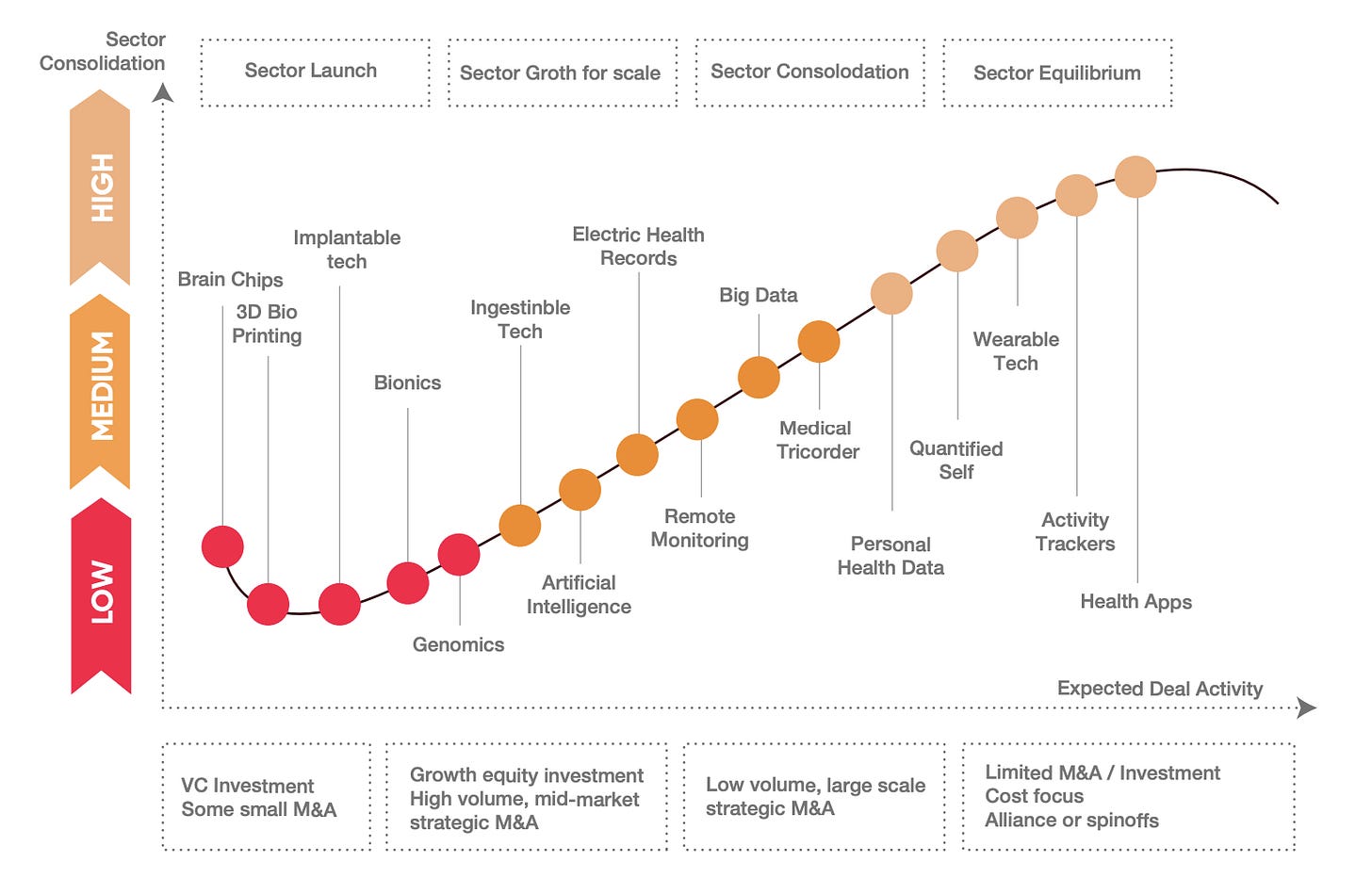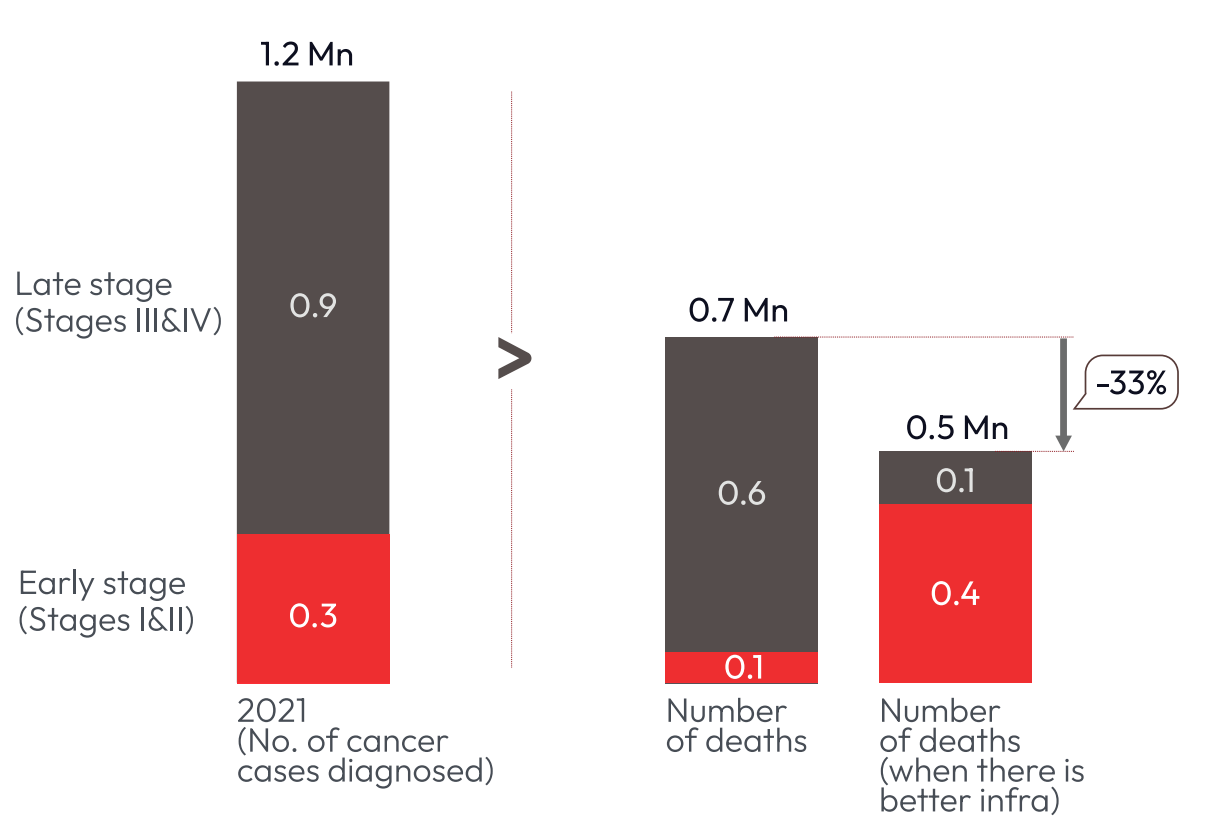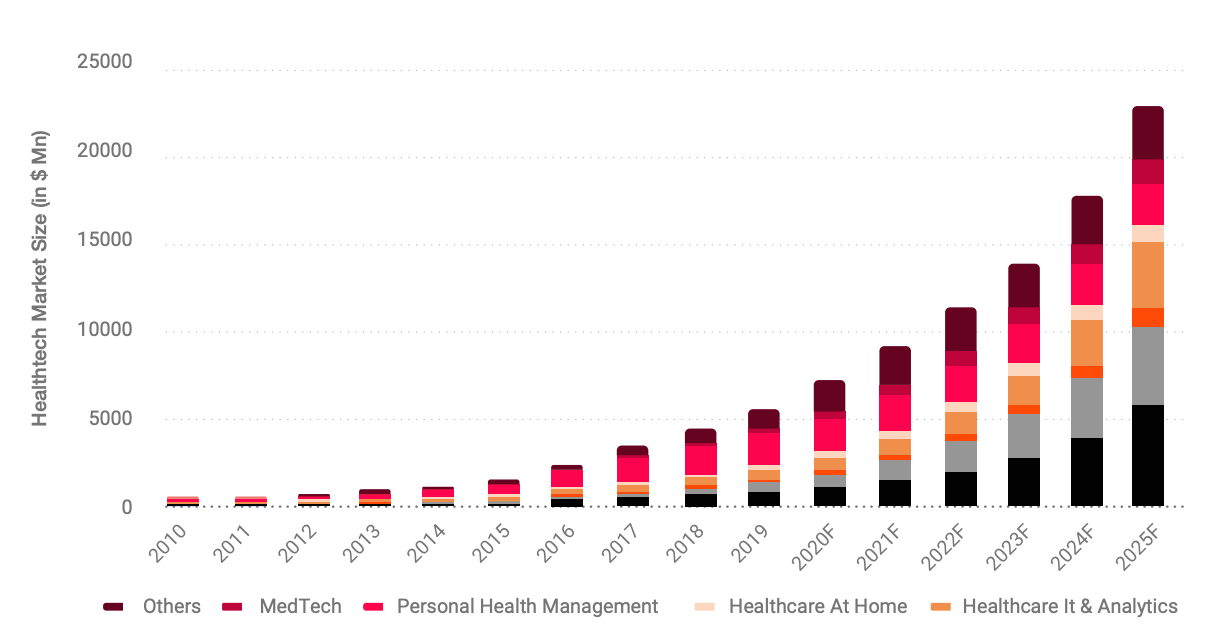HealthTech
Keeping in line with our sector-agnostic approach, for our fourth post today, we’re gonna be covering (you know the drill…*drum roll please*) …HealthTech!
Why?
The Indian health-tech market, currently worth $2 Billion which is less than 1%, of the overall healthcare industry in India, comprises segments like telemedicine, e-pharmacy, fitness, wellness, healthcare IT, analytics, home healthcare, and personal health management is expected to grow at a 39% CAGR over FY 2020-2023 and is expected to reach $5 billion by 2023 and $50 billion by 2033. E-pharmacy adoption in households also increased by more than 2x post-COVID and saw the use of a subscription model for chronic patients, to better manage medication for long-term diseases.
The HealthTech industry is currently led by players like Pharmeasy, Reliance-backed Netmeds, Tata group-backed 1mg, Medlife, mfine, and MeddiBuddy, among others. A Redseer report stated that a 47% increase in Net Promoter Score (NPS) in 2021 suggested that the customers are more likely to recommend the eHealth/HealthTech platforms to their friends or relatives.
What drives start-ups in this segment?
A global health emergency like coronavirus has put a big spotlight on the healthcare industry, with every stakeholder fighting from the frontline. The pandemic has been called a structural shift for digital healthcare in India.
With the telemedicine guidelines now in place and mandatory health insurance for workers, technology is well-placed to redefine healthcare infrastructure in India.
From wearables, telemedicine, online appointment booking, online medicine ordering, digital payment, genomics, database management, home healthcare, and diagnostics to monitoring health conditions through app or web portals, the Healthtech industry is opening a new dimension in the healthcare industry.
Healthtech Industry Consolidation S-Curve
Key Growth Drivers:
Need for improving accessibility:
High disparity in infrastructure between rural and urban areas; most notably in terms of unavailability of qualified practitioners in rural areas. According to the Medical Council of India, the doctor-patient ratio is as low as 1:2,000, if not lower than that. The fact is that most quality doctors practice in large cities where they enjoy more significant opportunities. Such practice, unfortunately, leaves a massive portion of citizens without primary medical care.
Technology-led solutions such as teleconsultation can improve accessibility
Increasing internet penetration:
A digitally savvy population with internet penetration of ~75% will further boost adoption in consumers.
Increase in lifestyle diseases:
Graying population, poor nutrition, a high-stress environment, a sedentary lifestyle, and rising environmental pollution are contributing to an increase in the burden of lifestyle and chronic diseases.
Need for affordable technology interventions for early diagnosis, prevention, and better disease management.
New innovations and improving affordability:
Increased focus of existing players in managing downstream costs; technology sought for augmenting resources, capabilities, and efficiencies.
Leapfrogging of concepts between the developed and developing markets.
Supportive policy regime:
E-pharmacy Draft Rules when notified will cement the role of E-pharmacies in improving accessibility to quality medicines.
The Govt has introduced NDHM, and eAccess to healthcare will be a key area for the country. However, regulation has been moving slowly in this space.
Ayushman Bharat and state health insurance will improve the paying power of the public for Health-Tech offerings such as teleconsultation.
Now let's talk about two important sub-themes under HealthTech for this segment:
#1 Preventive Healthcare
#2 Telemedicine
Preventive Healthcare:
Why?
Healthcare in India traditionally means “Curative” Healthcare (diagnosis & treatment). Curative healthcare spending constituted more than 64% of the total spending on healthcare in 2021 (private + government). Yet curative healthcare in India suffers from a highly strained infrastructure, and poor quality of healthcare and further worsened by limited affordability.
Prevention is the way to go forward to achieve better healthcare outcomes.
The Covid-19 pandemic fast-tracked consumers’ transition to digital payments in India with social distancing rules and the closure of many brick and mortar stores, shoppers embraced online channels even for their day-to-day purchases.
Curative Healthcare in India has a long way to go as it lags behind global health benchmarks significantly, which got exposed during the COVID—19 2nd wave in 2021. focus on prevention can result in much better patient outcomes:
#1 Focus on Prevention can result in much better patient outcomes
The majority of diseases are discovered when significant events such as heart attack, liver failure, etc happen; early detection of disease can save crucial resources for the relevant individuals. OTOH Breast cancer mortality rate is as high as 70% if diagnosed late and as low as 1% if diagnosed in stage 1. In India, overall mortality rates are north of 50% for breast cancer which means that it is not detected early on a mass scale across the medical spectrum/board.
Diabetes
>$3B saved due to diabetes-related complications if healthy lifestyle habits are followed
Cancer
>0.2MM lives saved every year with better infrastructure for early cancer detection
SRC: Chiratae, Inc42, ET
Now, on to our second sub-theme within HealthTech —> Telemedicine
#2 Telemedicine
The telemedicine Segment will be surging in the coming years and is expected to grow at a CAGR of 31% during 2020-25; Easy availability of healthcare services from distant places with a healthcare professional, lower cost, and quality services are major factors for the growth of telemedicine in India.
The healthcare infrastructure in rural areas is not good enough. Hence, telemedicine players are trying to target rural areas after entering Tier-II and Tier-III cities.
Top Spotlights In Telemedicine Services:
For mass adoption of telemedicine services, telemedicine players should rethink app quality and value for money
Genuine feedback is playing a vital role in the selection of telemedicine platforms
Seamless appointments and follow-ups are among the most demanded features by Indian consumers
Use Case:
#1 Online Pharmacy
Online pharmacy is in a very nascent stage in India. But there are several startups like 1mg, Netmeds, PharmEasy, and Medlife, amongst others, who are performing well in the Indian market. The lack of a structured regulatory policy is hindering the market in the current stage.
However, the online pharmacy market will witness sudden growth after regularised policy. The trustworthiness of online pharmacy players will play a vital role in ordering medicine online. The online pharmacy market is expected to reach $4.2 Bn by 2025 with a CAGR of 36%.
#2 Healthcare IT and analytics
Healthcare IT and analytics will play an important role in transitioning the healthcare sector to the tech side. From maintaining databases to analyzing diseases and providing correct treatment everything will be done effortlessly with the help of IT and analytics.
Healthcare IT and analytics will help to automate the processes and provide predictive analytics about risks. Even, insurance players are connecting with the analytics field for easy processing of insurance. The healthcare IT and analytics market in India will cross $3.5 Bn by 2025 covering more than 16% total health tech market share.
#3 MedTech
With the increase in the preventive care market, the healthcare diagnostic and personal health management market will see huge growth. The MedTech segment comprises diagnostic and therapeutics. The total MedTech market will reach $1.2 Bn. The personal health management market will be valued at $2.3 Bn by 2025.
——————————————
That's all for today! This space is for startups in the sectors and solutions we are bullish about, therefore, a call out if you are a founder working on any of the above use cases, you can reach us at connect@huddle.work and we look forward to brainstorming with you. If you are enablers and investors and would like a further look into our ecosystem, then we are happy to dive deep into these sectors alongside you.
See you next week, when we’ll be talking in detail about Huddle’s next sector of focus → AgriTech
PS - Our thoughts and thesis are inspired by what we learn from the ecosystem, our founders, investors, and experts. Therefore, some of these views are through other reports, and knowledge, and are continuously evolving.











